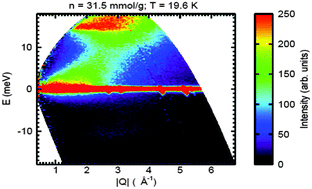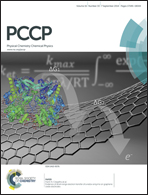Diffusive and rotational dynamics of condensed n-H2 confined in MCM-41†
Abstract
In this paper, we report an inelastic neutron scattering study of liquid and solid n-H2 confined within MCM-41. This is a high surface area, mesoporous silica glass with a narrow pore size distribution centered at 3.5 nm. The scattering data provides information about the diffusive and rotational dynamics of the adsorbed n-H2 at low temperatures. In the liquid state, the neutron scattering data demonstrates that only a fraction of the adsorbed o-H2 is mobile on the picosecond time scale. This mobile fraction undergoes liquid-like jump diffusion, and values for the residence time τ and effective mean-squared displacement 〈u2〉 are reported as a function of pore filling. In the solid state, the rotational energy levels of adsorbed H2 are strongly perturbed from their free quantum rotor behavior in the bulk solid. The underlying orientational potential of the hindered rotors is due to the surface roughness and heterogeneity of the MCM-41 pore walls. This potential is compared to the hindering potential of other porous silicas, such as Vycor. Strong selective adsorption makes the interfacial layer rich in o-H2, leaving the inner core volume consisting of a depleted mixture of o-H2 and p-H2.


 Please wait while we load your content...
Please wait while we load your content...